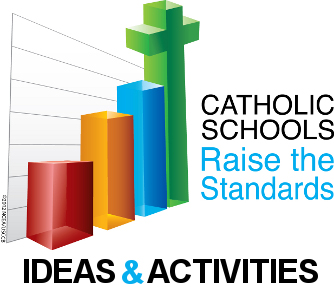I am so pleased to welcome back for the fourth time my wife Jennifer Dees and our good friend Meghann Kirzeder, who will share another set of Catholic Schools Week ideas and activities for 2013. They’ve shared so many ideas in the past that they wanted me to point you to their previous posts as a supplement to the two new ideas below. Many of the activities in these past posts will apply to any Catholic Schools Week theme:
- Catholic Schools Week Ideas and Activities 2010
- Catholic Schools Week Ideas and Activities 2011
- Catholic Schools Week Ideas and Activities 2012
Here’s Meghann and Jen:
Catholic Schools Raise the Standards in 2013
 This year’s theme for Catholic Schools Week is “Catholic Schools Raise the Standards.” Teachers and students in Catholic schools are called to more than high academic achievement–we are called to holiness, called to become saints. Does this mean, then, that academics take a back seat? Certainly not! We grow in holiness when we develop the gifts that God has given us, which includes learning all we can about the world around us so that we can, in turn, serve its greatest needs. Catholic schools, then, must help children grow both academically and spiritually–and it’s impossible to do one without the other.
This year’s theme for Catholic Schools Week is “Catholic Schools Raise the Standards.” Teachers and students in Catholic schools are called to more than high academic achievement–we are called to holiness, called to become saints. Does this mean, then, that academics take a back seat? Certainly not! We grow in holiness when we develop the gifts that God has given us, which includes learning all we can about the world around us so that we can, in turn, serve its greatest needs. Catholic schools, then, must help children grow both academically and spiritually–and it’s impossible to do one without the other.
With that in mind, here are two ideas to bring the theme of “raising the standards” into your classroom during Catholic Schools Week 2013, one with a heavy emphasis on literacy and the other focused more intently on mathematical measurement and problem-solving.
Catholic Schools Week Ideas
1. Focus on the Saints
If a “standard” is a benchmark against which we measure our efforts, then what higher standard can there be than sainthood? Throughout our history, the church has raised up these examples for us–what better opportunity to welcome your students into an exploration of the stories of the saints?
- Research the lives of saints on a level appropriate to the grade you teach. With very young children, perhaps you might read a biographical account of one well-known saint each day. With older students, you might challenge them to find multiple sources of information on a lesser-known or more obscure saint, perhaps with a particular connection to their own lives.
- Students can share the information learned using a wide variety of creative products: a newspaper, poster, “this is your life” sketch, social media profile, tv interview, costume and oral presentation, series of letters, journal, etc.
- Another idea might be to have students compare their saint to another figure, either in Scripture or in secular history. For example, a student could describe how both Joseph of the Old Testament and St. Maximilian Kolbe both turned their time in prison into an opportunity to use the gifts God gave them and save the lives of others.
- Another focus of the research and reporting might be on parallels to students’ lives. How can we imitate these saints in order to grow in holiness ourselves? This could lead to a class service project.
- Links to resources on saints:
- Patrick: Patron Saint of Ireland (for young students):
- 115 Saintly Facts (for intermediate grades)
- My Life With the Saints by Fr. Jim Martin (for high school students)
- Can You Find the Saints: Introducing Your Child to Holy Men and Women (just for fun)
2. Growing toward Goals
As a class, discuss the importance of standards and goals to help us grow to our potential. What are our most important goals for the remainder of the year? Why are these the most important? They may be related to a particular academic subject, or to classroom culture and student interactions, or to community service efforts.
- Once a goal has been selected (depending on your students’ ages, you may select one for the whole class, one per small group of students, or even one per student), challenge your students to determine how you will measure progress toward this goal.
- Set up a plan for regular assessment and objective measurement that can continue until the end of the year. For example, you might keep a running tally of books that have been read, average number of missing assignments, number of math problems the class can do in a minute, or student-ranked level of bullying behaviors taking place during a given week.
- Set up a plan for reporting results once they’re all in.
- As the year continues, follow your plans – conduct your measurements, report your results in tables, graphs, and narrative, and perhaps most importantly, interpret the results and share your findings!



Thanks Jared, I love reading your blog. Great ideas, great inspiration!
Here are a few of my favorite things – http://www.allisonwelch.com/myfirstyear/2013/01/catholic-schools-week.html
Happy Catholic Schools Week!
vtr
Dear Jared,
Our school decided one activity would be to decorate our doors and to use a saint for the theme… this way the class gets a “Patron saint” and they get to learn about that saint in the meantime, along with team work on creating the door. God bless and thanks!!
Hello Jared!
This is Sr. Rosa Dabhi CCV. I often use your blog for my lessons and they are indeed very helpful. Thank you for taking the trouble so that others may benefit. Wish you all the best for the Catholic Week. I did have a chance one to participate in this activity when I went to Guam. i really enjoyed. I wish we could have that in Taiwan too. May you be blessed abundantly!